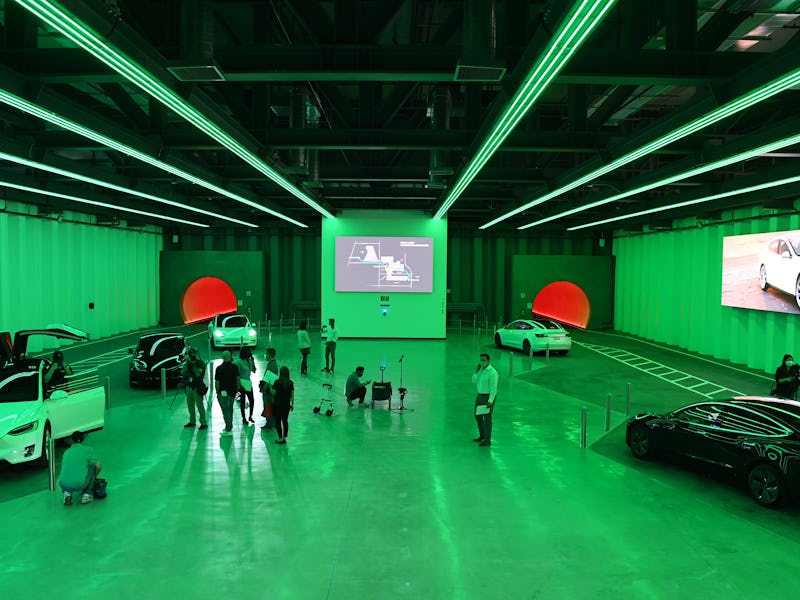The Boring Company: After Las Vegas, what’s next for Elon Musk’s firm
Full speed ahead?

The Boring Company is about to expand its first public route — and it’s about to link up the city of Las Vegas.
Last week, the company confirmed via Twitter that it’s set to expand its Las Vegas Convention Center project. The expanded version will offer 51 stations of publicly-available transportation over 29 miles.
The expansion will transform The Boring Company’s first project from a small line across a convention center into something that takes people across an entire city.
It’s the culmination of a six-year journey, which started when founder Elon Musk first told a Texas A&M audience in January 2016 that people should “build more tunnels.” It’s a journey that still has yet to deliver on a central promise of autonomous cars at 150 mph — the current public project sees human-driven cars moving around four times slower, at just 35 mph top speed.
It’s been an eventful — and at times rocky — journey:
- Musk announced the company’s name in December 2016 in a Twitter tirade against traffic
- He detailed his vision two months later: cities with up to 30 layers of tunnels, supporting the cars we already use
- In April 2017, The Boring Company released a video that showed cars and passenger pods moving through tunnels on skates
- In December 2018, Musk unveiled a 1.14-mile test tunnel in Hawthorne, California. He also tweaked the concept: instead of skates, it would be autonomous electric cars moving at speeds of up to 150 mph.
- In April 2021, The Boring Company opened its first public project: the Las Vegas Convention Center loop.
Here’s what comes next.
Want to find out more about The Boring Company’s plans to connect Las Vegas? Subscribe to MUSK READS+ for exclusive interviews and analysis about spaceflight, electric cars, and more.
The Boring Company: What has the company rolled out already?
In April 2021, The Boring Company opened its first public project. The Las Vegas Convention Center loop system offers three stations over two tunnels, with 1.7 miles of tunnels stretching over a distance of just under a mile.
The Las Vegas Convention Center loop.
The project cuts the 45-minute walk across the campus down to two minutes of driving time. The system uses Tesla vehicles to move customers across the convention center.
It cost $47 million to build as part of a firmly fixed pricing agreement. Ahead of the opening, the Las Vegas Convention and Visitors Authority agreed to not charge a ticket fare for rides on the loop, and it will instead earn revenue from advertising and rentals. The authority pays The Boring Company $167,000 per month to operate the system.
In May 2021, LVCVA president Steve Hill claimed on Twitter that the authority reached 4,400 passengers per hour in capacity testing. A 2011 paper from University of Calgary researchers suggests that this is comparable to the capacity of a busway — by comparison, the same paper found that metro lines can move from 11,000 to 81,000 passengers per hour per direction.
It should be noted that, despite promises that cars would move through The Boring Company’s tunnels autonomously at speeds of up to 150 mph, the cars currently use a driver and move at a maximum of 35 mph:
The Boring Company: What does Elon Musk plan next?
On October 20, commissioners in Clark County, Nevada, unanimously approved an expansion of this system. The new project will cover 29 miles of tunnels to connect 51 stations, connecting the McCarran International Airport to Las Vegas strip casinos and the Allegiant Stadium.
The company released a series of sample transit times and sample fares per vehicle:
- From McCarran Airport to the Las Vegas Convention Center, a distance of 4.9 miles, will take five minutes and cost $10 per vehicle.
- From the Allegiant Stadium to the convention center, a distance of 3.6 miles, will take four minutes and cost $6 per vehicle.
- From downtown Las Vegas to the convention center, a distance of 2.8 miles, will take three minutes and cost $5 per vehicle.
The Boring Company's planned Vegas Loop for the city.
The county claims the system could reach a capacity of around 57,000 passengers per hour.
The Boring Company: What comes after Vegas Loop?
The Boring Company’s website claims the Vegas Loop could eventually connect to Los Angeles over 200 miles away. Teslarati reported on Boring Company activity in August 2020 around Adelanto, California, which could facilitate such a connection.
Musk and The Boring Company have outlined several other potential projects:
- In March 2018, the company announced plans for a hyperloop-ready route to connect Baltimore and Washington, D.C. over 35 miles
- In June 2018 the mayor of Chicago, Rahm Emanuel, chose the company to build a connection between the airport and downtown area
- In August 2018 it proposed a 3.6-mile tunnel from the Los Angeles Dodgers Stadium to the nearby metro
- In January 2019, Musk told an Australian state lawmaker that it could connect Sydney to the west for a low price
- In February 2019, it emerged The Boring Company had conversations with San Jose, the city at the heart of Silicon Valley, about a connection between the airport and the main station
- In June 2021 it proposed a “Las Olas Loop” connecting downtown Fort Lauderdale and the beach. The proposal was formally accepted on July 7, and in October commissioners approved more detailed planning.
While negotiations are continuing for the Fort Lauderdale project, other plans seem less certain. In April 2021, the company’s website removed all mention of the three projects announced in 2018 — Baltimore, Chicago, Los Angeles — throwing their future into doubt.
SUBSCRIBE TO MUSK READS+, A PREMIUM NEWSLETTER THAT COVERS THE WORLDS OF ELON MUSK, SPACEX, TESLA, AND EVERYTHING BETWEEN.
This article was originally published on